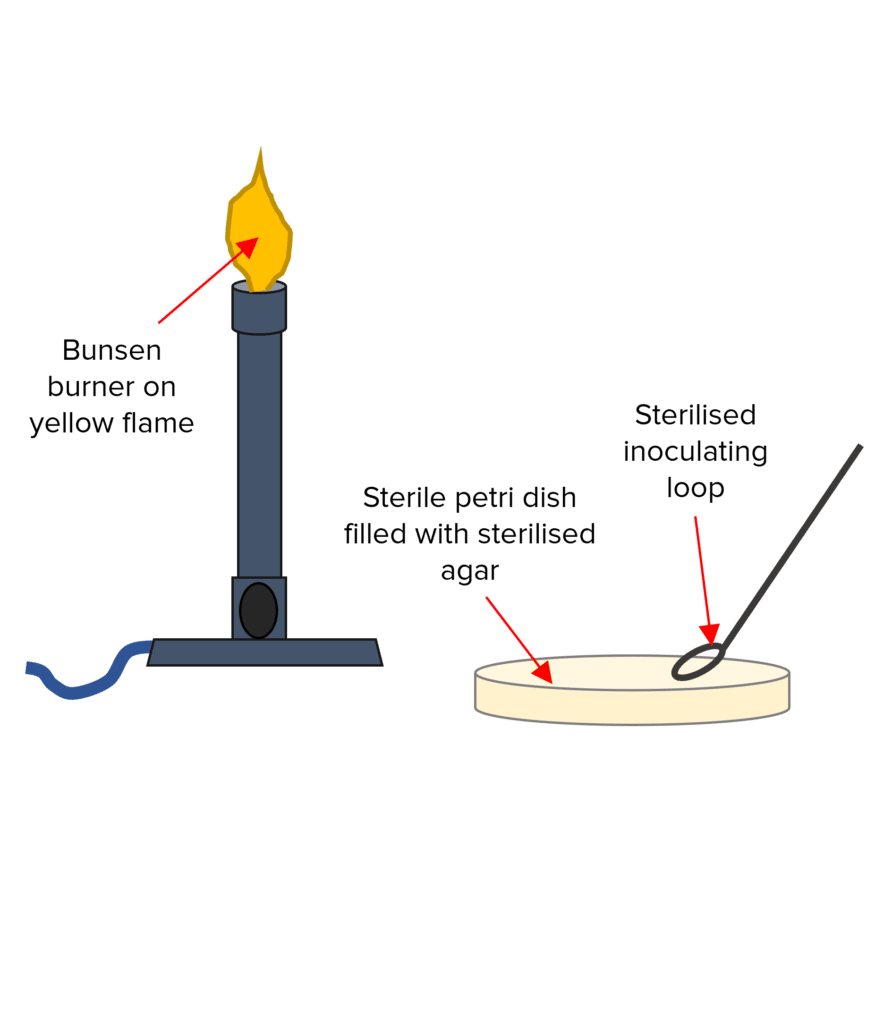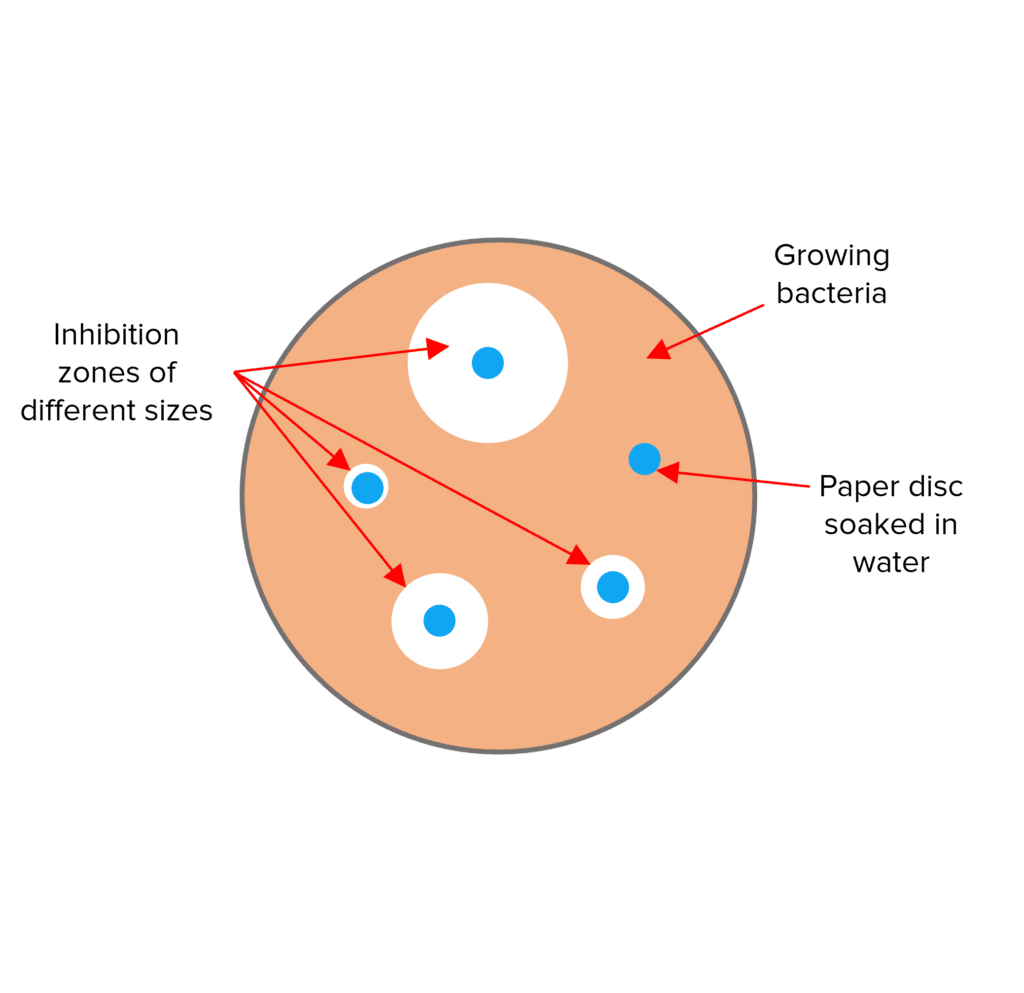Culturing Microorganisms
Culturing Microorganisms Revision
Culturing Microorganisms
Prokaryotic cells reproduce by binary fission and we can investigate their growth by culturing them in a lab.
Binary Fission

Binary fission is the process by which prokaryotic cells, such as bacteria, divide and reproduce. The speed of this division depends on conditions such as temperature and nutrient concentrations. Some bacteria can divide as often as once every 20 minutes but if conditions are unfavourable binary fission will stop and cells will start to die.
The process of binary fission is as follows:
- The genetic material stored in the circular DNA and plasmids get replicated
- The cell starts to expand and the circular DNA moves to opposite poles of the cell
- The cytoplasm divides and cell walls form around the 2 new daughter cells. Each daughter cell will contain a copy of the circular DNA and a variable number of plasmids.
Mean Division Time
The mean division time is the average time it takes for one bacterial cell to divide once.
Mean division time can be used to work out how many times a cell has divided and therefore the number of cells produced.
\text{Number of divisions} =\dfrac{\text{Time spent dividing}}{\text{Mean division time}}
\text{Number of cells produced} = 2^\text{ Number of Divisions}
Example: A cell has a mean division time of 20 minutes. How many cells will it have produced after 3 hours.
3 \text{(hours)} \times 60 = 180 \text{ minutes}\text{Number of divisions} =\dfrac{180}{20} = 9 \text{ divisions}
\text{Number of cells produced} = 2^9 = 512 \text{ cells}
Aseptic Techniques
Bacteria can be grown in labs in petri dishes that contain a growth medium. The growth medium contains all the molecules needed for the cells to grow and can either be a nutrient broth solution or solid agar jelly. Bacteria grown on agar gel plates will often form colonies on the surface.
As bacteria are found all around, it is important to reduce contamination when studying bacterial growth to prevent unwanted pathogens forming that can affect your investigations. these unwanted pathogens can also pose a risk to your health.
To create uncontaminated cultures when growing bacteria it is important to use aseptic techniques:

- Wash your hands and work surfaces before beginning to prevent contamination.
- Growth media must be heated before use to kill any bacteria living in it.
- Growth media must be added to a sterile petri dish.
- All work should be done in the presence of a Bunsen burner on a yellow flame to create a convection current above the bench and prevent contamination from the air.
- The Bunsen burner can also be used to sterilise equipment such as the inoculating loop that is used to transfer bacteria. Passing it through the flame will kill any bacteria.
- The lid of the petri dish must be taped on and opened as little as possible to prevent contamination from microorganisms in the air.
- The petri dish should be stored upside down to stop condensation falling on to the agar.
- The dish should incubated at 25°C to restrict the growth of harmful pathogens.
Required Practical
Investigating the effects of antiseptics and antibiotics on bacterial growth.
Preparing the petri dish
Remember to use aseptic techniques mentioned above to prevent contamination.
- Pour hot agar into the sterile petri dish and leave to cool and set. Then use a sterile dropping pipette and spreader to evenly spread the bacteria (this step may have already been done for you before you started the experiment).
- Soak paper discs in different types or concentrations of antibiotics and antiseptics for the same length of time and place them, evenly distributed, on the agar plate with the bacterial covering. This allows the antibiotic or antiseptic to diffuse into the agar.
- Place a disc that has been soaked in sterile water onto the plate as a control.
- Tape the lid onto the petri dish and incubate upside down for 48 hours.

Analysing the results
- There should be clear areas surrounding some of the discs of paper which is where the bacteria have been killed. These areas are called inhibition zones.
- The more effective the treatment is at killing bacteria, the larger the inhibition zone.
- Increasing the concentration of the solution increases the size of the inhibition zone.
- Some bacteria may be antibiotic-resistant and will be able to grow in the presence of the treatment so there will be no inhibition zone.
- You should notice that there is no inhibition zone around the control disc (water) and therefore it is the antibiotic/antiseptic that kills the bacteria.
Measuring inhibition zones
To truly compare how effective the different treatments are, you can calculate the area of the inhibition zones.
- Measure the diameter of zones of inhibition using a ruler.
- Half the diameter to get the length of the radius.
- Use \text{Area of a circle} =\pi\text{r}^2 to find the area of the inhibition zone.
Example: Find the area of inhibition of antibiotics X and Y to 2 decimal places and use them to decide which antibiotic is most effective against the bacteria in the plate.

\text{Area of X} =\pi\times\text{8}^2 = 201.06\text{ (2.d.p.)}
\text{Radius of Y} =\dfrac{12}{2} = 6\text{Area of Y} =\pi\times\text{6}^2 = 113.10\text{ (2.d.p.)}
Antibiotic X is more effective than antibiotic Y because
201.06>113.10
This method can also be used to find the area of a colony on the surface of an agar plate.
Note:
Remember if a number is very large or very small, it may be easier to express it in standard form.
Example:
2340000000 cells can be written in standard form as 2.34\times 10^{9} cells, which looks a lot neater.
Culturing Microorganisms Example Questions
Question 1: Describes the steps of binary fission.
[3 marks]
- Circular DNA and plasmids (genetic material) get replicated.
- Cell expands and circular DNA moves to opposite poles of the cell.
- Cytoplasm divides and new cell walls are produced.
- This produces 2 genetically identical cells with variable numbers of plasmids.
Question 2: A bacterial cell has a mean division time of 40 \text{ minutes}. How many cells will it have produced in 2 \text{ hours}?
[3 marks]
\text{Number of divisions} = \dfrac{120}{40} = 3 \text{ divisions}
\text{Number of cells produced}= 2^3 = 8
Question 3: Name 3 aseptic techniques a student should follow when carrying out a bacterial growth practical to prevent contamination.
[3 marks]
Any 3 from:
- Wash hands and work surfaces.
- Heat growth media before use.
- Use a sterile petri dish.
- Do all work in front of a lit Bunsen burner on a yellow flame.
- Sterilise equipment (inoculating loop) by passing it through a flame.
- Petri dish lid must be taped on and opened as little as possible.


